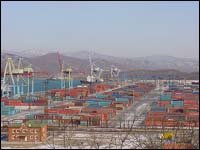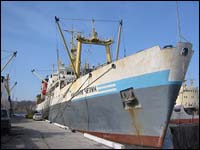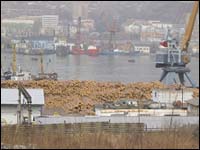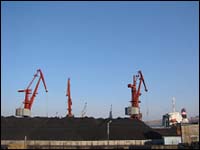 BRIEF OVERVIEW OF MAIN INDUSTRIES
BRIEF OVERVIEW OF MAIN INDUSTRIES
|
One of the results of the development of a "new"
market economy was a jump in the quantity of business
companies. There are 38,000 small businesses in
the Krai, eight times more than in 1998. 71% of
them are private businesses. Most of the companies
are located in cities; the number of rural enterprises
is dwindling. 472 farmers quit the agricultural
business in 2003.
The Primorsky Headquarters of the State Anti-Monopolistic
Committee recently submitted a draft law, "On
regulation of natural monopolies in the local markets
of Primorsky Krai," for approval to the Krai
Duma. In accordance to the draft, a new institution,
Regulating Commission, which will control prices
and tariffs, must implement the regulation. It would
be responsible for all decisions, as opposed to
the current Regional Energetic Commission, a public
organization. Ussyriisky Balsam, the leading distillery
producer in the Krai, has increased its production
by 30% in 2003, compared 2002. The company plans
to double its volume of production up to 1.8 million
gal of alcohol when its new department is opened
this year.
 THE PORT
THE PORT
|

of Vladivostok and Nakhodka are, many people would
say, the jewels in Primorsky Krai's industrial
crown. Both cities have excellent ice-free harbours
and many decades of development and experience.
Taken together, they handle more cargo of more
kinds than any other place in Russia. Due to Vladivostok's
strategic importance to the Soviet Union as a
military port, it was largely closed to the outside
world until the early part of this decade. Nakhodka
was the main commercial port of the Russian Far
East, a fact central to the founding of the Free
Economic Zone based on the city. Nakhodka's four
ports include Vostochny, which in addition to
being Russia's largest container port and one
of the regional stock market's 'blue chips', also
handles coal, metals, grain, and many other products.
Another major port and company is Nakhodka Commercial
Port, handling timber, metals, cars, food products,
etc.
Nakhodka's other two ports are the Oil Trans-shipment
Port and the Fishing Port. The latter is not,
as its name might imply, restricted to fish products.
It also handles various kinds of foodstuffs. Nakhodka
is continuing to develop, with new specialised
Timber and Fertiliser Trans-shipment Ports now
being constructed.
But Vladivostok, having had to play catch up,
has made up for lost time. Vladivostok Commercial
Port, which just celebrated its 100th anniversary,
handles both containers and bulk cargo, and is
a welcome addition to the port capacity of the
Vladivostok/Nakhodka region. Ports in the Russian
Pacific region of Primorye saw an 18 per cent
increase in cargo volumes during the first nine
months of this year, said a statement from the
Regional Administration on Monday. So far the
region's ports have handled 28,019 million metric
tons of cargo, and the year's total is estimated
to reach 36 million tons, said Igor Belchuk, head
of the regional transport department at a recent
meeting with port representatives. This represents
a 4 million ton increase on the same period last
year. One of the most promising ports is Vostochny,
Russia's largest deep-water port on the Pacific,
specializing in coal and container shipments,
said Belchuk.
 FISHING:
FISHING:
|
The importance of Primorsky Krai's ports is almost
self-evident. It is through them that Asia gets
its steel, Japan its timber and wood products, and
the Russian Far East receives its consumer goods.
The ports provide important support for the fishing
industry, which supply a large part of the region's
exports. Oct. 2001- Nakhodka mayor Viktor Gnezdilov
and Nakhodka duma speaker Mikhail Pilipenko sent
a petition to Russian President, presidential representative,
prime minister, State Duma speaker and State Fisheries
Committee on behalf of Nakhodka fishermen.

Nakhodka authorities are anxious about the situation
in the fishing industry caused by the introduction
of bio resource quota auctions. There are 34 fish
producing and fish processing companies in Nakhodka
operating a flotilla of 45 large-tonnage, 67 mid-tonnage
and 53 small-size vessels. Fishing industry accounts
for 76% of Nakhodka's total industrial output.
The introduction of pay quotas put the majority
of these companies on the brink of sustainability.
The letter gives an example of the base of Active
deep sea. Fisheries (BAMR), previously one of most
successful businesses in the industry.
|
During 2000 this company paid 720.52 million
roubles for quotas, deducted 501 million in tax
payments, and had only 168 million roubles of
net profit, which is too little to develop production,
renovate main assets and introduce advanced technologies.
In this connection, Nakhodka authorities and
fishermen come up with a number of proposals to
the federal authorities. In particular, they stress
that Russian fish producers should have an advantage
over foreign companies in the distribution of
fish quotas. In the first place, quotas should
be granted to national companies selling at least
50% of their output in the domestic market and
deducting considerable sums in tax and other mandatory
payments. A reasonable limit for quota payments
should not exceed half the profit gained from
it. Also, percentage of total allowable catch
put out at auctions, should not exceed 10% for
specific fishing areas.
 TIMBER:
TIMBER:
|

Russian forests comprise over one fifth of the world's
timber resources, yet wood production has plummeted
since the collapse of the Soviet Union. Poor infrastructure
and political uncertainty have made access to these
resources difficult; but there are small signs that
the Russian forestry sector is starting to stabilize
after years of decline.
Since 1993, Russian exports of unprocessed timber
have grown by 4 million cum to nearly 18 million
cum in 2002--an increase of 28%. The Russian federal
government is moving to privatise forestland ownership,
and new tax legislation is slated to provide tax
breaks for forestry investments. The pulp and paper
industry has already been largely privatised, with
several European firms buying up northwestern Russian
pulp mills.
Despite these developments, the need for significant
structural changes within Russia's forest industry
remain; but with vast quantities of mature wood-especially
the Russian Far East (RFE), where harvests are 50-60%
below the annual allowable cut-Russia will continue
to draw interest.
 COAL:
COAL:
|

Nakhodka has already implemented a scheme of this
kind for coal. Last year, the first shipments of
300 tons of Chinese coals were shipped via Vostochny
to Japan. "This year," continues Nakhodka's
Fedorov, "trans-shipments will be increased
to one million tons. All sides will benefit in this
cooperation: China will get the sales, Nakhodka
will make use of its transportation infrastructure
and Japan will get coal at a lower cost."
Vladivostok Commercial Port makes similar arguments,
noting that containers can be shipped from the US
West Coast to Harbin via Primosrki Krai in 2-3 days
less and at lower cost than via Korea (another alternate
route). Vladivostok Commercial Port is also focusing
on taking a large part of China's grain trade, noting
that "The Northeast provinces of Heilongjiang
and Jilin bordering on Russia play important role
in China's grain trade. Considerable volumes of
grain are transported into the other parts of China
and for export."
The traditional method for providing this region
with energy was through the installation of hydro
stations, such as the 1,200 mw Zeya and 720 mw Kolyma
power plants. New hydro stations planned before
the break-up of the Soviet Union and the collapse
of the Russian economy included the Bureya (2,000
mw) and Adycha (500 mw) plants. Over the years,
ambitious plans for nuclear stations have been drawn
up, but never materialized, apart from the tiny
48-mw Bilibino station located in the extreme north
of the Far East.
The Far East contains huge reserves of coal, although
most of it is located beyond economic accessibility
in the Lena basin, with deposits approaching 1,800
billion metric tons (metric units used hereafter).
Much smaller fields lie conveniently along the Trans-Siberian
Railway but consist mainly of poor-quality brown
coal.
The biggest producer is the Bikin field in Primorsky
Krai. Coal from this field fuels the 990-mw Primorsky
power stations at Luchegorsk. Unfortunately, the
energy strategy based on the development of coal
resources has not proved highly effective in the
1990s. The main consumer of electricity, the government,
has failed to pay for its energy use, so the power
stations have been unable to pay the coal companies,
who in turn, have been unable to pay wages to their
workers. Strikes, riots, and power cuts by coal
miners have forced the government to periodically
provide cash grants. After passing through the hands
of banks, however, these monies frequently got lost
on the way.
|

